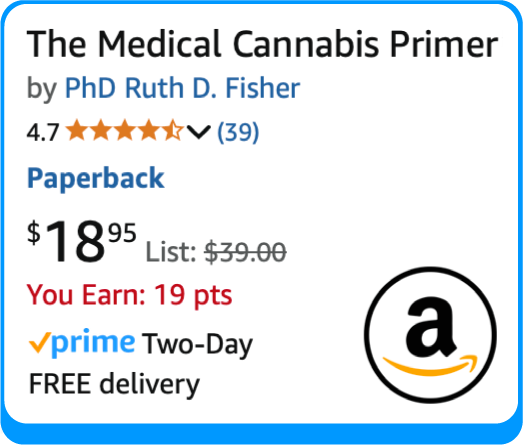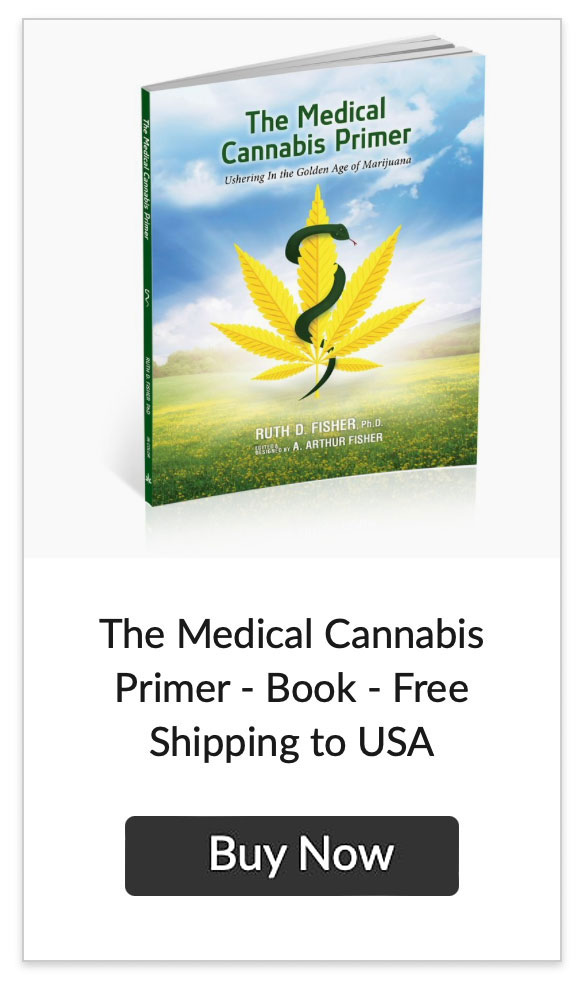Blogs
Preventing Recreational Cannabis from Squeezing Out Medical
Ruth Fisher
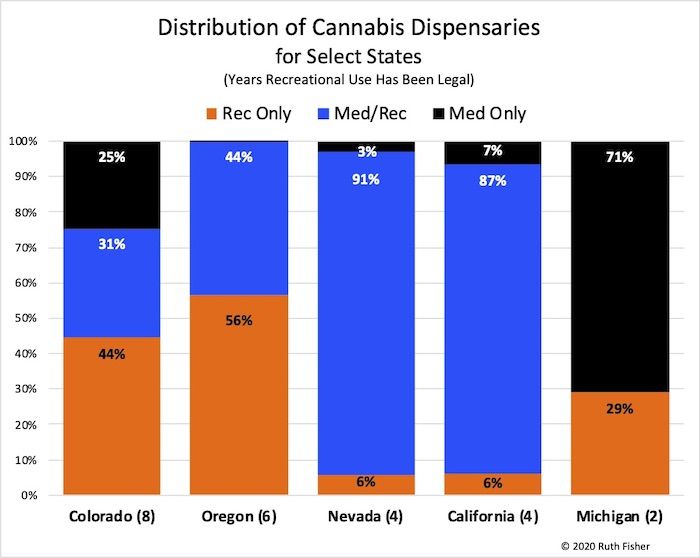
States that have legalized the sale and use of cannabis have generally exhibited similar patterns in cannabis sales over time. States start by legalizing medical cannabis. As medical cannabis programs are rolled out, numbers of cannabis patients and sales of medical cannabis products increase over time. After medical cannabis has been legalized for some years, many states eventually also legalize cannabis for recreational (adult use) purposes. If and when a state legalizes recreational cannabis, total cannabis sales continue to rise, where sales for recreational uses increase, but sales for medical uses decrease (see Figure 1).
Figure 1
Source: Marijuana Business Daily, with permission. See also MJ Business Daily's 8th Edition of their Fact Book.
When states legalized adult use cannabis, many medical users switch to adult use markets. At the same time, as adult use cannabis increases relative to medical cannabis, providers increasingly divert resources away from medical customers and toward recreational uses. In the process, the needs of medical cannabis users get squeezed out.
In states that have legalized both medical and adult use cannabis, new market incentive mechanisms are needed to encourage the provision of products and services that cater to medical cannabis users. Otherwise, medical users’ needs will very likely be lost as both patients and suppliers transition activities to adult use markets.
1. Cannabis Customers' Wants and Needs: Medical vs. Recreational
2. Market Dynamics of Cannabis Legalization
3. Needs of Medical Cannabis Users Get Squeezed Out
4. Incentivizing Provision and Use of Medical Cannabis
1. Cannabis Customers’ Wants and Needs: Medical vs. Recreational
The needs of medical cannabis patients differ from those of recreational cannabis users (see Figure 2). Medical users generally want medical guidance in their use of cannabis (Figure 2, row [C]). Especially given the great historical stigma surrounding cannabis, medical users may very well want reassurance that cannabis may help address their medical needs; they also want guidance on product selection and dosage, as well as information on potential drug interactions.
Next, medical users generally seek a wider variety of cannabis products – specific combinations of cannabis compounds (cannabinoids and terpenes) – to address their medical needs than recreational users seek (row [D]). Also, once a medical customer finds a particular cannabis product that meets his needs, that customer wants that particular product to be consistently available from the supplier over time (rows [E], [F], [G]). Conversely, while recreational users may find specific combinations of compounds provide better experiences for them, their needs to have those products be consistently available are less urgent than those for medical users. Notably, when cannabis supplies are scarce, some states (e.g., Illinois) give medical cannabis patients priority in supply over recreational users (row [H]).
Additionally, prices of medical cannabis products may be greater or less than those for comparable recreational products. Cannabis products generally carry both excise taxes and sales taxes. Medical users in many states are exempt from sales tax, but they must still pay excise taxes (row [I]). As for the price of the cannabis products themselves, medical products may be more or less expensive than recreational products, depending on both supply (numbers of growers that are producing a particular cultivar and/or form of use) and demand (numbers of customers that want a particular combination of profiles and form of use) (row [J]). Notably, some medical cannabis products –FDA-approved pharmaceutical cannabis products in particular – are reimbursable by health care insurance. Yet, most medical cannabis products are not reimbursable (row [K]).
Finally, states generally put limits on the amount of cannabis (milligrams of THC) customers can purchase or possess each day. As compared with adult use consumers, medical cannabis patients may purchase more milligrams of THC (row [L]), grow more cannabis plants (row [M]), and purchase products with higher THC content (row [N]) than corresponding limits for recreational cannabis users.
Figure 2

2. Market Dynamics of Cannabis Legalization
All the states that have legalized adult use cannabis have done so years after they have first legalized medical cannabis (see Figure 3). Initially, then, all dispensaries within a given state cater solely to medical cannabis patients.
Figure 3
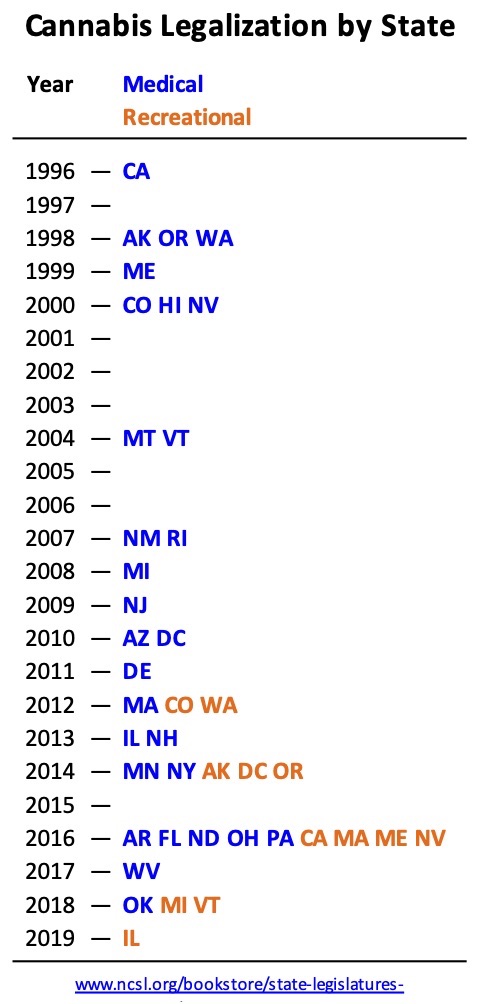
Medical vs. Recreational Cannabis Sales
As medical cannabis programs are rolled out within a state, numbers of cannabis patients and sales of cannabis products increase over time. If and when a state subsequently legalizes recreational cannabis, total cannabis sales continue to rise, where sales for recreational uses increase, but sales for medical uses decrease. Colorado’s experience, as displayed in Figure 4, is typical.
Figure 4
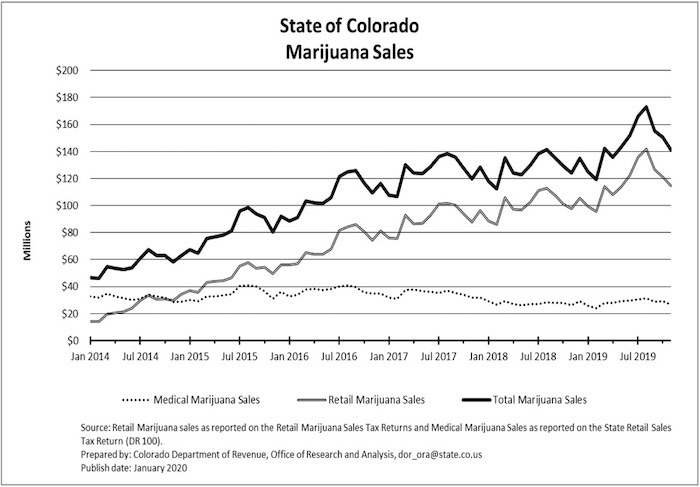
Source: Pace, E. (2019, Jan 13). Growth of Summit County, state marijuana sales levels off in 2018. Summit Daily. https://www.summitdaily.com/news/growth-of-county-state-marijuana-sales-levels-off-in-2018/
This trend of increasing adult use sales, with simultaneously decreasing medical sales, is well-documented. For example, Colorado Public Radio reports:
When states legalize pot for all adults, long-standing medical marijuana programs take a big hit, in some cases losing more than half their registered patients in just a few years, according to a data analysis by The Associated Press.
…
In Oregon, where the medical program shrank the most following recreational legalization, nearly two-thirds of patients gave up their medical cards, the AP found. As patients exited, the market followed: The number of medical-only retail shops fell from 400 to two, and hundreds of growers who contracted with individual patients to grow specific strains walked away. [1]
Medical vs. Recreational Cannabis Dispensaries
To iterate, when a state legalizes cannabis use, it starts with only medical cannabis legalization. Only years later do some states legalize adult use cannabis. Initially, then all (100%) dispensaries within a given state cater solely to medical cannabis patients. After adult use cannabis has been legalized, some medical dispensaries go out of business, while many existing medical dispensaries become dual-licensed in both medical and recreational cannabis. Additionally, new adult-use-only dispensaries enter the market.
Select state-specific distributions of dispensary licenses across medical and adult use categories are presented in Figure 5. For each state, the figure displays the number of years that adult use cannabis has been legal. States are presented from left to right in order of decreasing years since adult use has been legalized, from highest (8 years in Colorado) to lowest (2 years in Michigan).
Figure 5
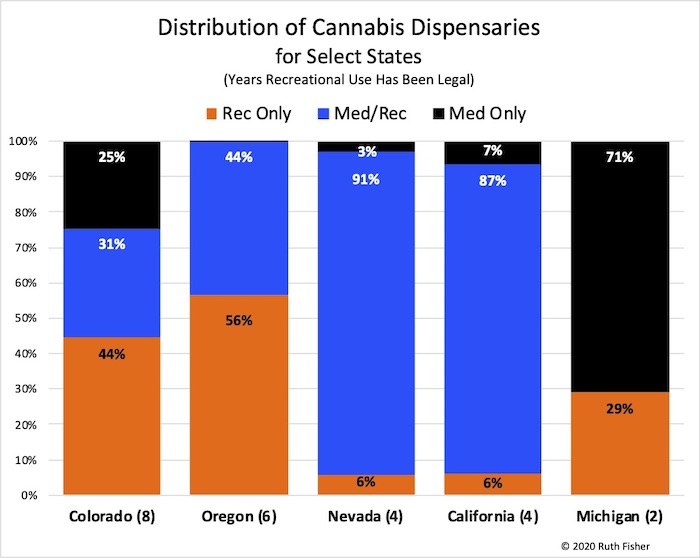
Figure 5 Sources:
CO: https://www.colorado.gov/pacific/revenue/colorado-marijuana-sales-reports, https://docs.google.com/spreadsheets/d/1PqYThJJwGEsrwWvciu9vXosuC0BzAw4YtD03RvlSKzE/edit#gid=0
OR: https://www.oregon.gov/olcc/marijuana/Pages/default.aspx, https://www.bizjournals.com/portland/news/2020/01/03/oregon-cannabis-sales-soar-in-2019-despite-vape.htmlhttps://www.oregon.gov/oha/ph/DiseasesConditions/ChronicDisease/MedicalMarijuanaProgram/Pages/dispensary-directory.aspx
NV: https://tax.nv.gov/uploadedFiles/tax.nv.gov/Content/MME/OpenDispensaries01222020.pdf, https://tax.nv.gov/uploadedFiles/taxnvgov/Content/TaxLibrary/Copy%20of%20NV-Marijuana-Revenue-FY19.pdf
CA: https://cannabis.ca.gov/check_a_license/, https://thcnet.com/news/california-cannabis-sales-grew-18-to-nearly-3-billion-in-2019
MI: https://www.mlive.com/public-interest/2020/06/michigan-recreational-marijuana-hits-milestone-surpasses-medical-marijuana-weekly-sales-in-upward-ascent.html
If recreational use dispensaries increasingly dominated medical use dispensaries over time, then distributions would show an increasing prevalence of medical use dispensaries as we move from the left to the right in the graph. This pattern is not present, suggesting other factors are affecting differences in state-to-state distributions of dispensaries across medical and adult-use markets. Unsurprisingly, cross-state differences in both regulations (e.g., availability of dual licenses) and market dynamics play a large role (as I discussed earlier in the section, Cannabis Customers’ Wants and Needs: Medical vs. Recreational), including those regarding:
- Cost and ease of obtaining medical vs. recreational use dispensary licenses
- Differences in costs, products, and complementary business services for medical and recreational cannabis use
Nevertheless, the figure does show a significantly increasing prevalence of recreational-only licensing or dual recreational and medical licensing over time over medical-only licensing.
Medical Cannabis Patients and Sales Defined
Before discussing why medical cannabis sales decrease after adult-use cannabis is legalized, let’s first understand how patient and sales data are assigned to medical versus recreational cannabis categories.
States have generally similar requirements for patients to qualify for medical cannabis cards:,
- Visit a doctor who is state-certified to “prescribe” (recommend) medical cannabis and qualify as suffering from one of the state-certified conditions that qualify for medical cannabis use.[2] (Leafly provides a list of qualifying conditions by state.[3]) Office visits reportedly range from $80 - $200. [4]
- Apply to the state for a medical cannabis card. Registration fees reportedly range from $35 - $200. [5]
- Visit a cannabis dispensary with a license to dispense medical cannabis and purchase cannabis products. [6]
- Renew medical cannabis certification regularly. States vary on frequency of required renewal, ranging from every 30 weeks to every 2 years. [7]
So then medical cannabis sales are those sales (i) by people registered with the state as having a condition that qualifies for medical cannabis use, and (ii) who purchase cannabis from a dispensary with a medical cannabis retail license.[8] If consumers purchase cannabis from recreational dispensaries, then even if the consumer uses cannabis for medical purposes, those sales are classified as recreational use. As a result, much of the sales activity classified as adult use is actually for medical use. That is, the medical vs. recreational data generally understate medical use activity and overstate recreational use activity.
Why Medical Cannabis Sales Decrease after Legalization of Adult Use
After states legalize cannabis for adult use cannabis, medical cannabis patient counts and sales both decrease, due to a combination of factors, the two most prevalent being: [9]
- Some cannabis users register as medical users so they can legally access cannabis, but once recreational cannabis is legalized, they no longer need a medical card to access the plant.
- For many medical cannabis users, the time and money costs of registering as a medical cannabis user aren’t worth the tax savings and/or higher purchase limits associated with being a medical, rather than a recreational, user. As Tim Cullen, who runs Colorado Harvest in Denver, puts it, [10]
Getting a medical card is also relatively onerous. A patient has to visit and pay for a physician, get a recommendation, file paperwork with the state and pay a small fee. Then they have to find a store and designate a caregiver.
“Or you can get the same or similar product on the recreational side, you pay a little more tax for it, but at the end of the day there’s a lot less planning and work that goes into it,” Cullen pointed out.
Notably, in many areas, recreational dispensaries are much more plentiful than medical dispensaries. All my research and experience in cannabis suggest that easy access to a local dispensary is an important driver of cannabis sales.
Generally speaking, then, the following conditions are more conducive to patients preferring to purchase cannabis as medical users rather than recreational users:
- Doctors’ fees are lower (or patients have to see their doctors anyway)
- Fees for registering as a medical cannabis patient with the state are lower
- The state allows medical cannabis for a wider variety of medical conditions
- State and local sales tax rates are higher
- Patients use larger amounts of cannabis
- Patients have easy access to medical cannabis dispensaries
3. Needs of Medical Cannabis Users Get Squeezed Out
After recreational cannabis use has been legalized and demand for adult use products starts to gain momentum, dual-licensed dispensaries tend to shift resources (shelf space and product variety) away from medical use products and toward products with greater appeal to recreational use consumers. Debbie Churgai, Interim Director of Americans for Safe Access,[11] provides more detail on this issue:
“A lot of times when legalization comes in the industry will focus on the prosperity that adult use will bring and sometimes they’ll switch out products that are mainly for patients for ones that are for the adult-use community,” Churgai said, adding that this can mean medical marijuana patients are less able to find the medicine they’re used to taking at their local dispensaries.
The same article also indicates that medical cannabis service providers are also negatively affected when recreational cannabis use squeezes out medical use:
When recreational cannabis legalization went into effect in California ... Almost simultaneously, medical marijuana consulting practices like Dr. Rachna Patel’s began to close their doors for good.
Alex Traverso, chief of communications for California's Bureau of Cannabis Control, [12] further emphasizes the need for regulators to make sure medical users do not lose access to affordable varieties of cannabis products in the face of growing demand for recreational cannabis:
"The challenge there is to do all we can to make sure that retail continues to focus on patients and give them proper guidance on products that can help their conditions," Traverso said when asked about the impact adult use has on California's medical market.
Like California, Oregon is also struggling with making sure affordable varieties of cannabis products remain available to medical cannabis patients:
In Oregon, regulators are struggling to find a path that preserves the state’s trailblazing low-cost medical pot program while tamping down on a still-thriving black market. A special state commission formed to oversee the market transition put out a report earlier this year that found affordability and lack of access are major hurdles for Oregon’s patients.[13]
4. Incentivizing Provision and Use of Medical Cannabis
It’s clear that, as demand for adult use cannabis starts overtaking that for medical cannabis, medical cannabis patients are increasingly challenged to find affordable varieties of medical use products. Interestingly, there’s a negative feedback loop at work here:
- As demand for recreational cannabis grows relative to that for medical use, dispensaries have an incentive to shift resources away from medical uses (the shrinking market) and toward recreational uses (the growing market).
- As resources for medical cannabis dwindle due to the increasing focus on adult use, the relative attractiveness of the medical cannabis package for patients decreases, leading more patients to shift to adult-use markets, thereby exacerbating the increase in relative demand for adult use cannabis.
Shifts in supply (dispensaries) and demand (patients) away from medical cannabis and toward recreational cannabis suggest that in current state environments, both dispensaries and patients find recreational use markets more attractive than medical use markets. The solution to this problem, then, is to figure out how to change current state environments (i.e., taxes and regulations) so as to increase the attractiveness to both dispensaries and patients of medical cannabis relative to that of adult use cannabis. Both these approaches are discussed in detail in the following sections and summarized below in Figure 7.
Increase Relative Demand by Medical Cannabis Patients
The first approach that can be taken to preserve ample supplies of cannabis for medical users is to increase demand for medical cannabis by patients. If the absolute demand of medical cannabis is robust, and/or if the relative demand for medical cannabis with respect to recreational cannabis remains compelling, then dispensaries will have an incentive to continue to cater to medical cannabis users. Demand for medical cannabis can be increased by addressing patients’ wants, which, as discussed earlier, include providing guidance in use, variety and availability of cannabis products, easy access, and affordable prices. Demand for medical cannabis would also increase if new applications of cannabis to address medical conditions were discovered.
Guidance in Use
Many patients have little-to-no guidance from their doctors about which cannabis products to use or how much to take. Regardless, they probably still have in mind their typical medication experience when they walk into a cannabis dispensary for the first time: People are used to having their doctors decide which medications to prescribe, and they are used to having their pharmacists decide which of the hundreds of medications on the shelves are appropriate for them (per doctors’ scripts). So then, when patients enter cannabis dispensaries and are faced with fantastic varieties of available products, they suddenly realize it’s up to them to decide which products to buy. This can be quite an overwhelming experience for new medical cannabis users.
As previously mentioned, medical users generally want guidance on cannabis product selection and dosage, as well as information on potential drug interactions. Medical patients will be much more inclined to use medical cannabis, if they know that the budtenders in dispensaries will provide some of the guidance they crave. Dispensaries can thus encourage medical cannabis demand by staffing budtenders who have enough knowledge to guide cannabis patients in their selection and use of medical cannabis.
Cannabis’s Colocation Problem
As I just mentioned, in the traditional medication market, doctors prescribe medications, while pharmacists fill them. This separation of duties serves several purposes. First, specialization enables efficiencies (more intensive utilization of assets), where doctors focus on the knowledge and equipment required to treat patients, while pharmacists focus on the knowledge and inventories required to dispense medication. Second, separation of duties prevents potential conflicts of interest on the part of physicians, preventing them from selling medications that patients don’t need.
What makes the separation of duties really work, however, is the relative standardization of medications. There are over 20,000 prescription drugs.[14] Each drug typically has a limited number of forms and dosages, where each dose of a given form is identical to the next. While some pharmacies compound specific formulations for patients,[15] the majority of dispensed drugs come directly from pharmaceutical companies. At the same time, there are specialty pharmacies that sell medications with “special handling, storage, and distribution requirements.”[16] As a result, standard pharmacies can leave specialty drugs to specialty pharmacies, stock only the most common medications, and order less common medications to be delivered within a short timeframe. Essentially, then, most medications a doctor prescribes will be available from the patient’s local pharmacy.
In cannabis, however, this is not the case (see Figure 6). Med Well claims, “There are currently at least 779 cannabis strains that have been named and recognized by the marijuana community.”[17] End products generated from cannabis isolates should be standardized across cultivars and batches. However, whole plant cannabis products generated from a given cultivar will differ from batch to batch, not to mention from dispensary to dispensary, depending on a batch’s cultivation and processing environment. So even if two dispensaries both carry OG Kush products, the product specifications will likely vary — a least a little bit, and perhaps quite a bit — across batches and across dispensaries. At the same time, while two different dispensaries may both carry OG Kush, they might carry different forms of cannabis products — flower vs. dab vs. vape cartridge — derived from the same strain.
Moreover, different dispensaries tend to carry whole plant products from entirely different cultivars, so a patient isn’t guaranteed that her local dispensary will carry products from the particular cultivar her doctor may have recommended. There are thousands of different cultivar-form combinations of cannabis products. Yet, dispensaries tend to stock a relatively small portion of the total cannabis products available. J. Louis Esquivel, General Manager at Cal Green Medical,[18] indicates that dispensaries stock anywhere from 200 (in a small store) to 1,200 (in a large store) different cannabis products (SKUs). So what’s a patient to do if the cannabis product her doctor recommends cannot be found at her local dispensary?
Figure 6
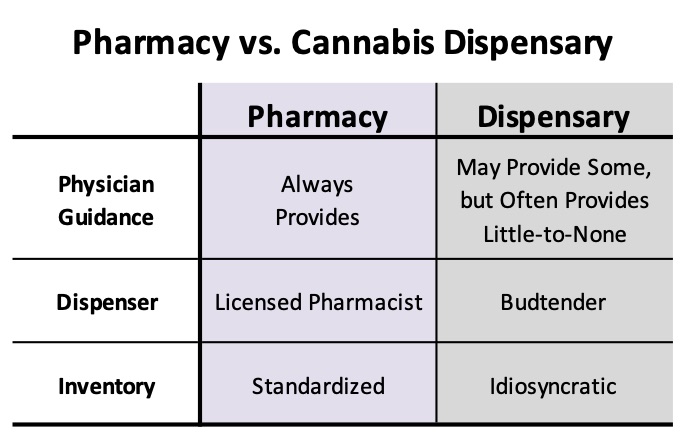
At some point, cannabis products may very well become standardized, at which point cannabis dispensaries will operate much like traditional pharmacies in stocking the same products. On the other hand, the beauty of cannabis is that it’s personalized medicine — different people prefer different cannabis cultivars and products. A large part of the attraction of cannabis is its large diversity of product offerings – people with different needs can all find cannabis products that work well for them. In this sense, hopefully cannabis will not become too standardized. Yet, given the current and conceivably ongoing diversity of cannabis products, how do we address the problem of aligning doctor recommendations with dispensary offerings?
There is an ideal solution with two possible forms that would address this problem. One form of an ideal solution is to have doctors sell the cannabis products they recommend directly to patients. The other form is to have dispensaries employ doctors who treat patients and recommend specific products from that dispensary. In both these cases, product recommendations and product offerings can be perfectly aligned. Unfortunately, conflict of interest regulations preclude either of these two scenarios. California Guidelines for the Recommendation of Cannabis for Medical Purposes[19] specifically state,
Accordingly, a physician who recommends cannabis should not have a professional office located at a dispensary or cultivation center or receive financial compensation from or hold a financial interest in a dispensary or cultivation center. Nor should the physician be a director, officer, member, incorporator, agent, employee, or retailer of a dispensary or cultivation center. A cannabis clinic or dispensary may not directly or indirectly employ physicians to provide cannabis recommendations.
The next best solution is for dispensaries to employ knowledgeable budtenders who can guide medical cannabis patients in their selection of cannabis products. Budtenders could guide patients who lack guidance from their doctors to find medical cannabis products in the dispensary that meet patients’ needs. Alternatively, if doctors recommend particular cannabis products that dispensaries don’t carry, budtenders could still use their knowledge to guide patients to similar products that dispensaries do stock. Of course, there’s the potential for conflicts of interest that the Medical Cannabis Guidelines specifically seek to avoid. Not to underemphasize the potential harm this problem could cause for medical cannabis patients, but this same problem could be said to exist with any retailer out there.
So, my previous conclusion still holds: Dispensaries can encourage medical cannabis demand by staffing budtenders who have enough knowledge to guide cannabis patients in their selection and use of medical cannabis.
Variety and Availability
Relative to adult use cannabis users, medical cannabis patients demand a wider variety of cannabis products (profiles of ingredients) and have greater urgency in finding consistent availability of the products that work for them. Dispensaries can thus encourage demand from medical cannabis users by continuing to stock and restock products with profiles that meet medical users’ needs.
Shortages of appropriate medical cannabis products have become a problem in many adult use states, due to limited availability of licenses for cannabis dispensaries, which creates a shortage of shelf space for retail products. Alex Traverso, Chief of Communications for California's Bureau of Cannabis Control,[20] provides more detail on this problem:
Local control can make things challenging, as there are still far too many cities and counties in our state that ban commercial cannabis activity. Without more retail storefronts, patients have a tougher time getting access to products, and growers and manufacturers have fewer locations where they can sell their products.
Aggravating the shelf space shortage for medical users is the increasing practice by dispensaries of charging slotting fees from cannabis cultivators and product manufacturers for the limited space available.[21] Slotting fees increase prices to suppliers, which disproportionately burdens smaller cannabis cultivators and manufacturers, and thus product variety. And by increasing prices to suppliers, slotting fees also increase prices to customers, which is especially burdensome to medical users (see section below on Price).
It follows that states can help encourage supply and demand for medical cannabis by increasing product availability, specifically, increasing the number of retail licenses available for medical cannabis dispensaries. Notably, as of early 2019, “Two-thirds of California municipalities prohibit marijuana businesses from setting up shop.”[22] It would clearly go a long way toward increasing supply if more cities and counties would legalize cannabis activity within their jurisdictions.
States can also encourage variety of medical cannabis offerings by enabling direct-to-consumer sales of cannabis by cultivators and manufacturers. Direct-to-consumer sales would directly address the shortage of shelf space problem. For its part, the Federal government can encourage variety of medical cannabis offerings available to patients by descheduling cannabis and permitting interstate sales. Legalizing direct-to-consumer sales and/or legalizing interstate sales of cannabis products would vastly enhance demand for medical cannabis products. Interstate sales will become legal if and when the Federal government reschedules cannabis; direct-to-consumer sales might also become more available if and when cannabis is rescheduled.
Access
Today more than ever, consumers demand convenience.[23] Consumers are much less likely to consume a product that’s difficult to access. In fact, consumers are purchasing more and more goods online (especially during the Covid crisis),[24] and they are increasingly less willing to travel long distances to find stores that carry the products they may otherwise want.[25]
Accordingly, medical cannabis demand can be increased by making supplies of medical cannabis products more accessible to consumers. This can occur either by
- Increasing availability of dispensary licenses in areas where they have already been legalized,
- Increasing the number of jurisdictions in which medical cannabis activity is legal, and/or
- Legalizing interstate or direct-to-consumer sales of medical cannabis.
Prices
Patient expenditures on (non-pharmaceutical) medical cannabis products are generally not reimbursable by health insurance companies or tax deductible for Federal income tax calculations.[26] Medical cannabis purchases are thus generally cash expenses, which many patients find to be prohibitively expensive. Dr. Julia Arnsten, chief of the Division of General Internal Medicine at Montefiore Medical Center has this to say:[27]
“Most people that do find medical cannabis helpful end up spending $200 to $300 a month,” said Dr. Julia Arnsten, chief of the Division of General Internal Medicine at Montefiore Medical Center, located in the Bronx, New York, amid some of the poorest congressional districts in the United States. “When you tell them they're going to have to spend at least $100 to even get enough medical cannabis to determine whether it's helpful for them, many of the patients just start crying. They say, 'Are you kidding me? Where am I going to get $100?' It's unfathomable to them to be able to spend that kind of money.”
Two ways to increase consumer demand for medical cannabis products are thus to make medical cannabis, ideally, reimbursable by health insurance, or at least tax deductible.
At the same time, cannabis prices are so high mainly due to heavy taxes and burdensome regulations suppliers face in bring cannabis products to market. Government can thus have a large impact on encouraging demand for medical cannabis products by decreasing the taxes on medical cannabis and/or by reducing the burden of regulations on cannabis suppliers, either of which will decrease prices patients must pay.
New Medical Applications
The discovery by researchers of new applications of cannabis compounds to treat medical conditions would increase both the absolute and relative demand of medical cannabis. Currently, medical researchers are burdened by the Schedule I classification of cannabis. This classification makes it more difficult for researchers to secure funding for their studies, it makes it more difficult to obtain good samples of cannabis to use in research, and it makes it quite burdensome for researchers to handle cannabis in the process of conducting their research. Obviously, then, rescheduling cannabis would go a long way in easing the burden to researchers of working with cannabis, which would speed the discovery of more medical applications of cannabis, and thus consumer demand for medical cannabis.
Increase Relative Supply by Medical Cannabis Dispensaries
The second approach that can be taken to preserve ample supplies of cannabis for medical users is to increase supplies of medical cannabis products relative to those for recreational cannabis. If medical cannabis is more accessible, then patients will have greater incentives to purchase it. Supply of medical cannabis can be increased either by decreasing costs to medical cannabis suppliers or by increasing demand from medical cannabis users.
Decrease Costs
As just mentioned in the section on Prices, suppliers face many taxes and burdensome regulations to bring cannabis products to market. Taxes and regulations increase the costs to suppliers of providing cannabis, which then increases the price to consumers of purchasing cannabis. High higher prices decrease legal market purchases of both medical and adult use cannabis, as well as driving consumers to lower-priced, black market purchases of cannabis.
Government can have a large impact on encouraging demand for cannabis in general, and medical cannabis in particular, by decreasing the taxes on medical cannabis and/or by reducing the burden of regulations on cannabis suppliers, either of which will decrease prices patients must pay, thereby increasing demand.
At the same time, the Schedule I classification of cannabis increases the costs to providers of supplying cannabis, by increasing the costs of complementary services need to perform everyday business operations. More specifically, the Schedule I classification of cannabis precludes cannabis suppliers from using traditional banking and payment services. Lack of access to banking increases suppliers’ costs of business by forcing them to use alternatives to traditional banking and payment services, many of which are more costly and/or less efficient than traditional services.
Likewise, cannabis’s Schedule I classification prevents many complementary service providers who are already providing services to non-cannabis markets from extending their service offerings into the cannabis market. In particular, lab testing service providers in the cannabis industry are all new (and inexperienced) companies that sprang up to provide services exclusively to cannabis suppliers. Existing testing services with experience in non-cannabis botany testing refused to expand into the cannabis market, due to the associated risks for their non-cannabis operations.[28] The shortage of testing labs in general, and experienced testing labs in particular, increases the costs to cannabis suppliers of providing cannabis products for customers.
Rescheduling cannabis would facilitate the provision of less expensive services that suppliers need to perform business operations, thereby increasing demand for cannabis in general and medical cannabis in particular.
Increase Demand
This was covered in the previous section, Increase Relative Demand by Medical Cannabis Patients.
Summary
Figure 7 summarizes what’s needed and how to achieve what’s needed to increase medical cannabis demand and supply, thereby ensuring the continued robustness of medical cannabis markets.
Figure 7
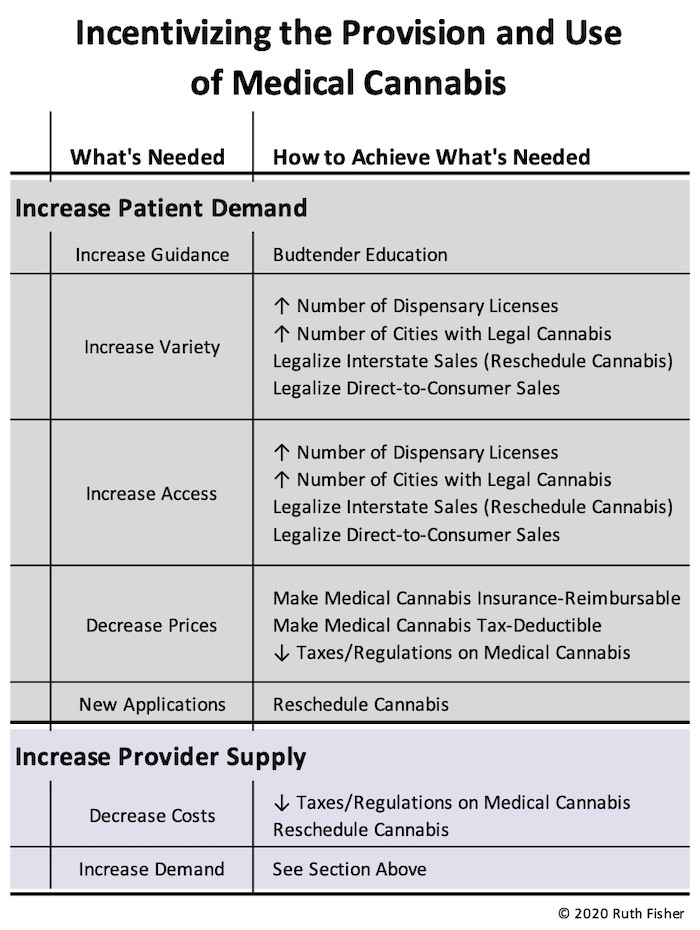
Supply and demand for recreational cannabis is increasingly overpowering medical supply and demand, due in large part to the regulations and restrictions on cannabis supply and use. As I’ve repeatedly emphasized, rescheduling cannabis should facilitate much-needed support for the medical cannabis industry in the face of large demand for adult use products. If rescheduling doesn’t happen soon, however, medical markets may very well shrink in adult use states, unless or until rescheduling does happen.
Dispensaries can help mitigate these problems by educating budtenders to provide much-needed guidance to medical users. State and local government can significantly address these problems by increasing the prevalence of jurisdictions in which cannabis activity is legal, by increasing the numbers of medical dispensary licenses, and/or by decreasing taxes and regulations on cannabis activity.
References
[1] Associated Press (2019, Jun 11). Wherever Recreational Marijuana Flourishes You’re Sure To Find An Equally Wounded Medical Cannabis Market. Colorado Public Radio. Retrieved from https://www.cpr.org/2019/06/11/wherever-recreational-marijuana-flourishes-youre-sure-to-find-an-equally-wounded-medical-cannabis-market/
[2] AMG (2020, Aug 13). Differences Between Medical Cannabis vs Recreational Marijuana. Green Health Docs. Retrieved from https://greenhealthdocs.com/medical-vs-recreational-marijuana/
[3] Leafly Staff (2020, Jan 29). Qualifying conditions for medical marijuana by state. Leafly. Retrieved from https://www.leafly.com/news/health/qualifying-conditions-for-medical-marijuana-by-state
[4] Medical Marijuana Card Costs. CostHelper. Retrieved from https://health.costhelper.com/medical-marijuana-cards.html
[5] Medical Marijuana Card Costs. CostHelper. Retrieved from https://health.costhelper.com/medical-marijuana-cards.html
[6] AMG (2020, Aug 13). Differences Between Medical Cannabis vs Recreational Marijuana. Green Health Docs. Retrieved from https://greenhealthdocs.com/medical-vs-recreational-marijuana/
[7] AMG (2020, Aug 13). Differences Between Medical Cannabis vs Recreational Marijuana. Green Health Docs. Retrieved from https://greenhealthdocs.com/medical-vs-recreational-marijuana/
[8] Hollingsworth, M. (2019, Jul 31). What’s the Difference Between Medical & Recreational Marijuana? CannaMD. Retrieved from https://www.cannamd.com/whats-the-difference-between-medical-recreational-marijuana/
[9] McGovern, S. (2019, Apr 8). Will Medical Cannabis Sales Eventually Surpass Recreational Sales? Green Entrepreneur. Retrieved from https://www.greenentrepreneur.com/article/331484
[10] Markus, B. (2018, Aug 15). Colorado Medical Marijuana Sales Take A Nosedive. Is The End Nigh? Colorado Public Radio. Retrieved from https://www.cpr.org/2018/08/15/colorado-medical-marijuana-sales-take-a-nosedive-is-the-end-nigh/
[11] Hartman, B. (2020, Jan 29). What Happens to Medical Cannabis When It Becomes Legal for Everyone? Cannigma. Retrieved from https://cannigma.com/cannabis-news/what-happens-to-medical-cannabis-when-it-becomes-legal-for-everyone/
[12] Ward, A. (2020, Feb 19). A Snapshot Of America's Medical Marijuana Markets: California. Benziga. https://www.benzinga.com/markets/cannabis/20/02/15280535/a-snapshot-of-americas-medical-marijuana-markets-california
[13] Associated Press (2019, Jun 11). Wherever Recreational Marijuana Flourishes You’re Sure To Find An Equally Wounded Medical Cannabis Market. Colorado Public Radio. Retrieved from https://www.cpr.org/2019/06/11/wherever-recreational-marijuana-flourishes-youre-sure-to-find-an-eq
[14] Fact Sheet: FDA at a Glance. 2019, Oct. US Food & Drug Administration. Retrieved from https://www.fda.gov/about-fda/fda-basics/fact-sheet-fda-glance
[15] Wikipedia contributors. (2020, Aug 14). Compounding. In Wikipedia, The Free Encyclopedia. Retrieved from https://en.wikipedia.org/w/index.php?title=Compounding&oldid=973017705
[16] Calla, N. (2013, Dec 18). What Is a Specialty Pharmacy? Pharmacy Times. Retrieved from https://www.pharmacytimes.com/publications/specialty-pharmacy-times/2013/Nov_Dec-2013/What-Is-a-Specialty-Pharmacy
[17] Cannabis Strains: How Many Different Kinds Are There? Med Well. Retrieved from https://www.medwellhealth.net/cannabis-strains-different-kinds/
[18] J. Louis Esquivel. Personal Communication. September 11, 2020.
[19] Guidelines for the Recommendation of Cannabis for Medical Purposes. 2018, Apr. Medical Board of California. Retrieved from https://www.mbc.ca.gov/Download/Publications/guidelines-cannabis-recommendation.pdf
[20] Ward, A. (2020, Feb 19). A Snapshot Of America's Medical Marijuana Markets: California. Benziga. https://www.benzinga.com/markets/cannabis/20/02/15280535/a-snapshot-of-americas-medical-marijuana-markets-california
[21] Schroyer, J. (2019, Jun 27). California marijuana retailers charge product suppliers for shelf space, creating friction in the industry. Marijuana Business Daily. Retrieved from https://mjbizdaily.com/california-marijuana-retailers-charge-product-suppliers-for-shelf-space-creating-friction-in-the-industry/
[22] Schroyer, J. and McVey, E. (2019, Feb 18). Chart: Most California municipalities ban commercial cannabis activity. Marijuana Business Daily. Retrieved from https://mjbizdaily.com/chart-most-of-california-municipalities-ban-commercial-cannabis-activity/
[23] The Quest for Convenience. 2008. The Nielson Company. Retrieved from https://www.nielsen.com/wp-content/uploads/sites/3/2019/04/the-quest-for-convenience-5.pdf
[24] Estay, B. (n.d.). 16 Online Shopping Statistics: How Many People Shop Online? Big Commerce. Retrieved from https://www.bigcommerce.com/blog/online-shopping-statistics/#5-essential-online-shopping-statistics
[25] National Consumer Study Summary. 2016-2017. Access Development. Retrieved from https://cdn2.hubspot.net/hubfs/263750/Access_Consumer_Spend_Study_2016.pdf
[26] Intuit Accountants Team (2020, Jan 2). “Legal” Marijuana and the Federal Tax Law. Intuit Accountants Tax Pro Center. Retrieved from https://proconnect.intuit.com/taxprocenter/tax-law-and-news/legal-marijuana-and-the-federal-tax-law/
[27] Amelinckx, A. (2019, Aug 27). Marijuana Access Expands, but Prices Keep Medicine Out of Reach for Many. Weedmaps. Retrieved from https://weedmaps.com/news/2019/08/marijuana-access-expands-but-prices-keep-medicine-out-of-reach-for-many/
[28] Halford, B. (2013, Dec 9). Analyzing Cannabis. Chemical and Engineering News. Retrieved from https://cen.acs.org/content/dam/cen/91/49/09149-scitech.pdf

